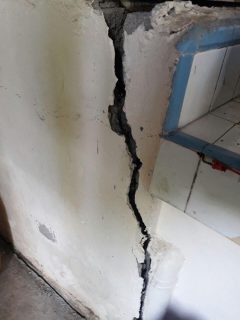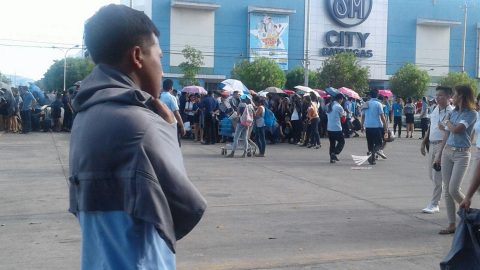
(Eagle News) – What happened in Batangas was an “earthquake swarm” — a series of quakes without a distinct very large earthquake – and there is no sign it has stopped, according to the director of the Philippine Institute of Volcanology and Seismology (PHIVOLCS) Renato Solidum Jr.
For Phivolcs, what was the main “shock” before of April 4 recorded at 5.5 magnitude had been replaced by this 6.0 magnitude of last Saturday, April 8, and they are not discounting the possibility that quakes of similar magnitude would again occur in the area.
As of yesterday afternoon (April 8), PHIVOLCS has already recorded more than a thousand aftershocks, including those which could be felt by seismology machines, 140 of which had been plotted. Twenty of these were reported felt by the population in the affected areas. Until Sunday morning, however, the aftershocks continue.
“If you ask me how I will describe the earthquake, I will describe it as an earthquake swarm, meaning there is a series of earthquake events with no very distinct large earthquakes. However, if you ask me what is the highest magnitude, it’s magnitude 6, and typically the highest magnitude is considered the main shock. But the episode is not finished yet,” said Dr. Solidum in an interview with eaglenews.ph Saturday night after the series of strong quakes in Batangas.
Before the April 8 quakes in the province, PHIVOLCS has regarded the April 4 quake with a magnitude of 5.5 as the “main shock” meaning the strongest quake, and the quakes that followed were mere aftershocks that would have lesser magnitudes.
But with what happened yesterday, this scenario was changed. It is an “earthquake swarm” and there is no discounting the possibility that more strong quakes would occur in the area, said Solidum.
“Kasi dati, ang ginagamit is yung 5.5 is the mainshock, pero ngayon ito mas malaki, so tatanggalin mo na yun as the main shock,” the PHIVOLCS chief told Eagle News.
“So the best way to describe this series of earthquakes is that there is an ongoing earthquake swarm,” he added.


Solidum said this such an earthquake swarm is not unusual.
“This has happened in many parts of the country. That is better than having a major fault movement generating a
major earthquake. More devastation will happen in the area. It is better to have an incremental movement,” he explained.

-Metro Manila should still prepare for “Big One”
But even with the earthquake swarm happening in Batangas, people in Metro Manila should stay prepared and be
vigilant for the so-called “Big One” in the Philippine capital since the fault line which moved in Batangas, is a different fault line from the one here in Metro Manila which is the West Valley Fault.
He said the “big one” – the quake which the public is preparing for in Metro Manila, is still a possibility. The magnitude 6.0 quake in Batangas “can be the “big one” only for the town of Mabini, he explained.
“There are other big ones for other areas. It can be the “big one” for Mabini, who knows?” Solidum said.
“Remember a big one is the earthquake related to a particular earthquake scenario, or a particular area. So ang Big one na sinasabi mo more or less Metro Manila, hindi ‘yan yan. (That is not it),” he explained referring to the Mabini, Batangas magnitude 6.0 quake.
“And that fault is not related at all to the West Valley Fault,” he stressed.
Vigilance is still a must, Solidum said, and people in Metro Manila should continue to prepare for the so-called Big One, “whether or not there was an earthquake in Batangas.”
The so-called “earthquake swarm” still happening in Batangas won’t lessen the danger of a big quake in Metro Manila.
“Of course yes, because you are talking about different faults. As I said, it’s not related to the West Valley Fault, so kahit anong kilos nya, walang pakialam sa West Valley Fault. (Whatever its movement, it has no relation to the West Valley Fault). And these are not connected faults,” Solidum explained.
A series of quakes – the strongest of which were magnitude 5.6 and 6.0 — shook the province of Batangas at past 3 p.m. Saturday, April 8, and were felt in other Southern Tagalog provinces and parts of Metro Manila.
The quakes were tectonic in origin, with its epicenter near Mabini town in Batangas, where they were felt at intensity 7.
The quakes were felt at intensity 6 in Calatagan, Nasugbu and Tingloy towns in Batangas; at intensity 5 in Batangas City, Sto. Tomas and Lemery also in Batangas, and in Tagaytay City; intensity 4 in Dasmarinas, Cavite, Lucena City, and Pateros City; intensity 3 in Makati City, Pasay City, Quezon City, Muntinlupa City, Malabon City, Mandaluyong City, Bacoor, Cavite; and intensity 2 in Daet City.
The first strong quake on Saturday afternoon had a magnitude of 5.6 which struck Batangas at 3:07 p.m., followed by a stronger quake at magnitude 6.0 that rocked the province two minutes later, at 3:09 p.m.
At 3:29 p.m. Saturday, an aftershock with a magnitude of 4.1 hit San Luis town in Batangas, followed by a still stronger aftershock with a magnitude of 4.7, with the epicenter again in Mabini town at 4:36 p.m.
Until Sunday morning (April 9), the quakes continued, with one even reported 33 kilometers west of Lubang, Occidental Mindoro with a magnitude of 4.7. This quake occurred earlier at 1:26 a.m.
The United States Geological Survey (USGS) had earlier reported the quakes in Batangas at 5.5 magnitude at 3:08 p.m., and at magnitude 5.9 at 3:09 p.m., Saturday, with the reported epicenters just a kilometer northeast of Barangay Bagalangit in Mabini, Batangas, and one kilometer southwest of Barangay Talaga in Tanauan, Batangas.







